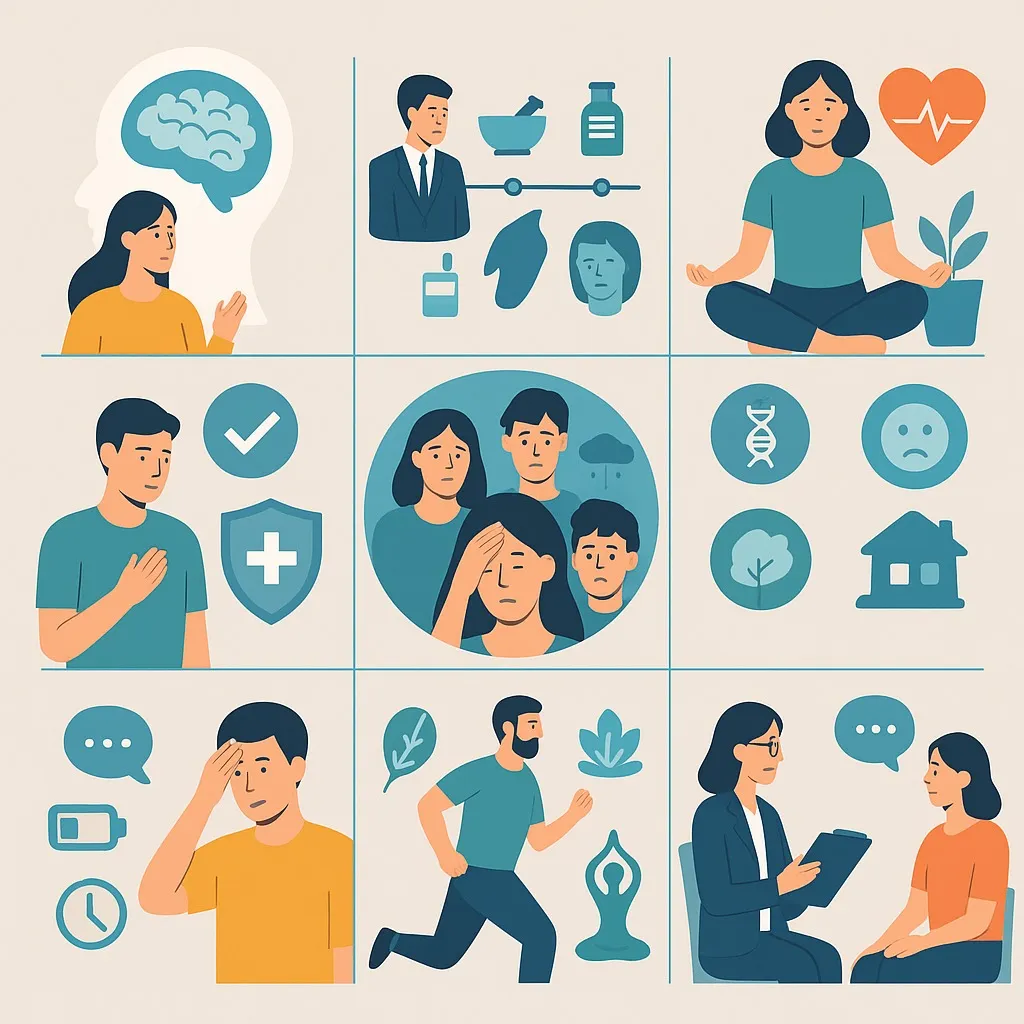Understanding Mental Health: A Complete Guide to Emotional Well-Being
Mental health has become one of the most important topics of the 21st century. As society grows more complex, stress, anxiety, and emotional challenges affect millions worldwide. Whether it is managing daily responsibilities, coping with trauma, or striving for a balanced life, our mental well-being plays a central role. In this comprehensive guide, we will explore the meaning, importance, challenges, and solutions related to mental health, arranged in a clear timeline of understanding - from its origins to future perspectives.

1. The Meaning of Mental Health
Mental health refers to a person’s emotional, psychological, and social well-being. It influences how we think, feel, and behave in daily life. Good mental health does not mean the absence of mental illness, but rather the presence of balance, resilience, and the ability to cope with stress.
According to the World Health Organization, mental health is more than just the absence of disorders; it is a state of well-being where individuals can realize their potential, work productively, and contribute to their community.
Defining Core Elements
- Emotional regulation
- Ability to build and maintain relationships
- Positive self-image and confidence
- Coping with stress and change
2. A Brief History of Mental Health Awareness
Historically, mental health was misunderstood and often stigmatized. Ancient societies attributed mental illness to spiritual or supernatural causes. Treatments were frequently harsh and ineffective.
During the 19th and 20th centuries, psychology and psychiatry began to emerge as scientific fields. Institutions evolved from asylums into centers for research and care, shifting the view of mental illness from punishment to treatment.
Key Milestones
- 1800s – Development of early psychiatric hospitals
- 1900s – Introduction of psychotherapy
- 1950s – Rise of modern psychiatric medications
- 2000s – Global campaigns for mental health awareness
3. The Importance of Mental Health in Daily Life
Mental health directly affects physical health, relationships, work performance, and overall life satisfaction. People with strong mental well-being tend to have better resilience against challenges and healthier lifestyles.
Neglecting mental health can lead to burnout, chronic stress, and physical illnesses such as heart disease or weakened immunity. Thus, protecting mental well-being is as essential as maintaining physical health.
Benefits of Good Mental Health
- Improved focus and productivity
- Stronger emotional resilience
- Better physical health outcomes
- Healthy social interactions
4. Common Mental Health Disorders
Millions of people worldwide struggle with mental health conditions. These disorders vary in severity and symptoms but all affect quality of life. Understanding them is the first step toward reducing stigma.
Major Categories
Anxiety Disorders
These include generalized anxiety disorder, panic disorder, and phobias. Symptoms include constant worry, restlessness, and physical signs like a racing heart.
Depression
One of the most common mental health conditions, depression causes persistent sadness, loss of interest, and low energy. It can interfere with work and relationships.
Bipolar Disorder
This condition involves extreme mood swings, ranging from manic highs to depressive lows. Managing bipolar disorder often requires medication and therapy.
Post-Traumatic Stress Disorder (PTSD)
PTSD develops after traumatic experiences such as accidents, war, or abuse. Symptoms include flashbacks, nightmares, and emotional numbness.
5. Causes and Risk Factors
Mental health challenges rarely have a single cause. They often arise from a combination of biological, psychological, and social factors.
Biological Factors
Genetics, brain chemistry, and family history play a significant role in mental disorders. Imbalances in neurotransmitters like serotonin and dopamine can lead to conditions such as depression.
Psychological Factors
Past trauma, chronic stress, and poor coping mechanisms increase vulnerability to mental health struggles.
Environmental Factors
Unstable home environments, poverty, or exposure to violence can heighten the risk of mental illness. Work-related stress and social pressures also contribute.
6. Signs and Symptoms to Watch For
Recognizing the warning signs of poor mental health is essential. Early detection often leads to better treatment outcomes.
Emotional Signs
- Persistent sadness or hopelessness
- Excessive worry or fear
- Irritability and mood swings
Behavioral Signs
- Withdrawal from friends and activities
- Difficulty concentrating
- Changes in sleeping and eating habits
Physical Signs
- Unexplained headaches or stomach aches
- Fatigue and low energy
- Increased use of alcohol or drugs
7. Strategies for Improving Mental Health
Maintaining strong mental health requires active effort. Small, consistent practices can bring long-term benefits.
Healthy Lifestyle Choices
Exercise, balanced nutrition, and quality sleep are fundamental for emotional balance. Regular physical activity releases endorphins, improving mood.
Mindfulness and Relaxation
Practices like meditation, deep breathing, and yoga help reduce stress and enhance emotional stability.
Building Social Connections
Strong relationships provide emotional support and a sense of belonging, which are essential for mental well-being.
8. Treatment and Professional Support
When self-care is not enough, professional help is vital. Effective treatment improves symptoms and restores quality of life.
Therapy Options
Cognitive Behavioural Therapy (CBT), psychotherapy, and counseling are common methods to address mental health concerns.
Medication
Antidepressants, anti-anxiety drugs, and mood stabilizers can be prescribed by professionals to manage specific conditions.
Support Groups
Peer support communities allow individuals to share experiences, reduce isolation, and gain encouragement.
9. The Role of Society in Mental Health
Mental health is not only a personal responsibility but also a social issue. Stigma, discrimination, and lack of resources continue to create barriers.
Workplace Mental Health
Employers are increasingly recognizing the importance of mental wellness programs to boost employee morale and productivity.
Government and Policy
National health systems and NGOs play critical roles in providing access to affordable mental health services.
Community Support
Educational campaigns, school programs, and local support networks help build awareness and reduce stigma.
10. The Future of Mental Health
The future of mental health looks promising as technology, research, and awareness continue to evolve. Digital platforms now offer online therapy, apps for mood tracking, and AI-based support systems.
Increased global collaboration is helping break stigma and make mental health a priority. Personalized treatments and preventive approaches will shape the next generation of care.
Emerging Trends
- Teletherapy and digital counselling
- Wearable devices monitoring stress and sleep
- Integration of mental health into primary care
- Global movements for awareness and acceptance
Conclusion
Mental health is a cornerstone of human well-being. From history to modern challenges, it is clear that emotional health shapes every part of life. By understanding common disorders, recognizing warning signs, adopting healthy strategies, and supporting one another, we can build a healthier future. Ultimately, good mental health empowers individuals to live fully, contribute positively to society, and face life’s challenges with resilience.











